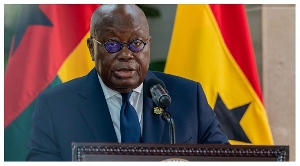Opinions of Friday, 28 March 2014
Columnist: Fekpe, Charles Kofi
Minor indigestions from the Bawumia lecture
By Charles Kofi Fekpe
It’s very common knowledge, that a camel can go without water for many many days – interestingly, research shows a giraffe can go without water, much longer.. It makes me wonder how long Ghana can go on without a stable economic life or better still, a solid mechanism to quickly and effectively stabilize any misdirected economic accident as and when they happen. At least, not until I read the scripts of the Lecture by Dr Bawumia on Ghana’s ailing Economy on 25th March 2014.
“At the heart of the problem is the lack of fiscal and monetary discipline” – I couldn’t have agreed more with this statement. More importantly, I would also like to know what the Government has done with $20 billion of development monies of the last few years. And I totally agree too, with his corrective/stabilization measure recommendations at the end of his lecture. I was however hoping that after all was stabilized, what next? What do successive governments have to do to ensure that any stabilization is solidified economically speaking at least in the medium term?
These having been said and purely out of respect and for the purposes of complimentary discourse, there were some arrears of the Honourable economist’s presentation that could do with some defence. Seeing that they form a fundamental context of his position.
1. Dr Bawumia indicates that “To bridge the gap between black market and official exchange rates, foreign exchange bureaus were established in February 1988, leading to the virtual absorption of the foreign exchange black market. The cedi exchange rate therefore became market determined with an increase in demand for foreign currency resulting in depreciation……” Do we interpret this to mean that, it was only when the Forex Bureaus were established in 1988 that the Cedi started being influenced by the demand and supply market? Shall we in extrapolation thus also assume that the black market should not be considered part of the currency influencing market because of their black nature? – that’s a bit of an exchange rate racist discrimination sir, don’t you think? Sir?
2. Dr Bawumia says the only reason for the Cedi Depreciation in the periods before 2014 is because we moved from fixed rates (established by the British West African Currency Board (WACB)) to floating rates? He forgets that in the era of the fixed rates, it was in the interest of Britain to keep the rates at par with the GBP, because they technically owned both currencies. After independence, I am sure the Dr will agree that keeping the rates at the British Colonies’ standardization would have meant, effectively, chaining the economic management of Ghana and her currency to Britain’s Economic policies – effectively we would have social independence but no Financial Management liberty. As far as his lecture notes show, he has only explained the Cedi’s depreciation in 2014, as being due to economic fundamentals. Sir, it didn’t all just happen in 2014 according to your graph, depreciation has been on the up from independence. I wish the Dr would explain to us why the depreciations in the 40+ years prior? Or shall we then conclude that returning to Fixed rate exchange mechanism will correct everything about the Cedi.
3. Skewed Comparisons:
a) Sir you start off the partial causative analysis by indicating that Ghana’s currency exchange was fixed under the The British West African Currency Board (WACB) and you compared the Est African Pound to the British Pound, then in analysing the result of the causative issues, you switch to the Cedi versus the US Dollar – why the dissimilar parameters for comparison? Sir?
b) Over the period 1965 to 2012 you compare the USD/GBP and the GhS/USD and conclude that whereas the GBP appreciated by 1.5% over a 48 year period, the Cedi slumped by 2,000,000%. That’s an intentionally skewed comparison to make. Why wasn’t the Cedi:USD fluctuation compared to the fluctuation against the USD of a country with similar economic, social and historical backgrounds like Nigeria or Kenya? Sir?
4. The Dr said “Declining economic growth is worrying because without an expanding economy we cannot create jobs and many of you students will find it difficult to find jobs when you complete your studies….” – it would be good to know if as an economist, our focus should be on job creation or productivity. Let’s be brutally honest sir, if job creation were to be considered as an end in itself, then Hitler did it by employing every citizen in digging trenches and making bombs. Are you sure the real worry is in the creation of jobs or the nation’s productivity? Sir?
The Dr said, very correctly, that excessive government spending domestically and the financing of such increased spending using direct cash injections has been one of the main factors causing the exchange rate slump because it fundamentally meant more Cedis chasing fewer Dollars – I agree and believe too, that this is a critical issue that will impact on short, medium and long term economic performances of Ghana. As critical as this is however and knowing that Government insofar as the population and economy was expanding no matter how little, will continue to need increased spending – The Dr made no offer of measures that governments ought to carry out to generate, increase and sustain local revenue, seeing that he suggested in the body of his lecture, a reduction in levies, taxes and rates, and in contradiction, a scrapping of tax holidays in order to make the cost of doing business Ghana attractive to investors – although I would have argued that corruption and uncertainty also add substantively to the cost of doing business in Ghana. So, just how, effectively, should Government generate income other than by expanding revenue catchment through biometric means and social formalization – assuming these will require public spending which the Dr has suggested need cutting down sharply immediately.
Dr Bawumia, in putting Ghana’s Public Debt Interest payments in perspective says that total interests payable in 2014 is 6 times the budget of these 6 “KEY” ministries namely: Ministry of Roads, Trade/Industry, Fisheries, Food/Agriculture, Water/Housing and Transport. Sir, I don’t know how you determined the “KEY” ministries, but if you were trying to compare the hugeness and centrality of the interest payments, it would have been comparatively fair to compare it with the equally HUGE and in my opinion, “CENTRALLY KEY” ministries such as Finance, Defence, Education, Food/Agric, Health and Energy/Petroleum, in which case you would have realised that the interest repayments for 2014 only amounts to 0.5 TIMES the combined budgets of these 6 “CENTRALLY KEY” ministries. Does that shift the arguments a little? Sir? Oh by the way sir, according to the publicly available budget documents on the website of the MoFEP, you said the total budget allocated to Ministry of Roads was GhC779mil – it is actually GhC699; you said that for Fisheries was GhS279mil – it is actually GhS128; You said Food and Agric had GhS128 – it is actually GhS306. Sir?
Dr Bawumia, does a brilliant table that compares Months of Import Cover (MiC) per liquidity for Ghana (pop 25mil), India (pop 1.3bil) Indonesia (pop 249mil), Malaysia (pop 31mil), South Africa (pop 52mil), and of course, Ghana compares very poorly – Did the Dr fail to acknowledge that national productivity does generally have some linear relationship with population sizes or was it a slip of intent?. It was unclear the source of the data and whether or not these were averages over time or as at the end of 2013. We don’t know. But how about we compare apples with apples? How about we compare African countries with similar levels of populations and the picture doesn’t look too bad all of a sudden at the end of 2013 (from World Bank sources): Kenya (Pop=44mil; MiC=4); Uganda (Pop=35mil; MiC=5); Ivory Coast (Pop=23mil; MiC=4); Mozambique (Pop=24mil; MiC=3) and Ghana (Pop=24mil; MiC=3). On World Bank Datasheet website, Seychelles has an MiC of 40, Algeria MiC=34 and Lybia MiC=41; Comparatively, will Dr Bawumia therefore say the following countries are comparatively close to economic extinction? i.e. USA MiC=2, Denmark MiC=6 and France MiC=2. Conclusively, using the Months of import cover on its own is not enough to explain a country’s liquid stability without understanding the basics of it such as the nature of imports, the relative type of the country’s export, the timings etc.
All in all, I think it was a largely positive and forward-looking presentation barring that I was hoping his recommendations would have been ones that looked beyond stabilization and into medium to long term actions of depth. Congratulations sir. You have done well breaking one horn of the bull……… the rest, is in all our hands. As I have always reiterated, resources are nothing without the people to convert them into wealth. So too are agendas and policies without the right people to implement them – as far as we can all see, our economy and therefore, the currency, which is a reflection also of that economy, is a reflection of the mental and creative majority of us, as a people; sadly, the required critical mass of citizens, needed to stabilize the thinking and creative base of Ghana currently lies in the hands of our majority illiterates.
Charles Kofi Fekpe
fekpe@hotmail.com












